Oh the dill pickle. The pickled cucumber is a special enough pickle that we simply call it a pickle. A pickled beet is a pickled beet, and a carrot that has been pickled is a pickled carrot, but a pickled cucumber, well that is just a pickle. Where was I going with this? Oh now I’m in a pickle. Anyways, is there anything better than biting into a pickle and hearing that crunch… aww this is a good one. On the flip side, isn’t it awful to bite into a pickle and find that it’s completely soft? So dissatisfying. I actually was never a huge fan of pickles until recently, but I can remember my grandpa always having a pickle on the side of a grilled cheese sandwich. I wish he was here today to judge in this pickle experiment I am about to tell you about. So how do you achieve the perfect pickle? Well, there are a few options I sought to test.
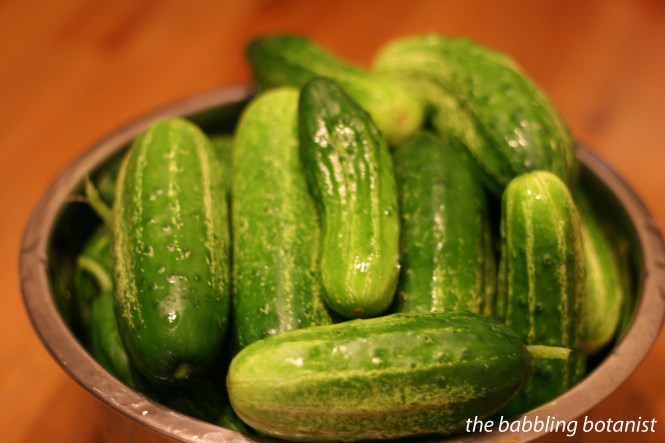
One way to make pickles is through the process of fermentation, but this type of pickling will be addressed in a later post. The reason for that is because they produce a different product in many ways than making a quick pickle, so for this experiment I wanted to test two of the most common methods of crisping quick pickles – those that are placed in vinegar and processed immediately.
Pickle Crisp
Pickle crisp is a product put out by ball, but I’m sure other brands sell it as well. All it contains is calcium chloride, which is supposed to help maintain the firmness of pickles. You simply add a very small amount to each jar when you are packing them. Quick, easy, and just calcium chloride.
Low temperature pasteurization
Generally, when we process foods in jars to make them shelf stable, we do so in a boiling water bath canner, with the water at a full rolling boil (or of course in a pressure canner for low acid foods). Quick pickles of all types are traditionally made this way, and most canning book instructions will tell you to do it that way. However, when some extension service or food science folks somewhere (I forget the exact details of Janice’s anecdote) started digging deeper into how pickles are processed industrially, they discovered something very interesting. Pickles were being processed at lower temperatures, which can help maintain that crispy, crunchy texture that we all love about pickles. So, it was time for some science! Can we safely process at lower temperatures at home? Yes, it turns out we can. Maintaining the temperature between 180-185F for 30 minutes is a safe way to process certain tested recipes, all of which can be found in PNW 355. To process your pickles at low temperatures, there are a few things that are a bit different. First, you pack them as you would normally, then place the jars in a half filled canner with warm water (120-140F). Then add hot water, until an inch above the jars, and heat the canner to 180F and start the timer. Try not to exceed 185F or it sort of defeats the purpose of low temperature pasteurization. The frustrating part can be that you have to watch it a bit more closely than when you are processing in boiling water, because you don’t want to drop below 180F or go above 185F. Unless you have a sweet electric canner with set temperatures, like the one that OSU extension has for classes (which by the way is impossible to find on sale anywhere), you need a thermometer, like this long one to check the temperature, or this sweet one with an alarm that goes off when you reach the set temperature. Then all you do is process them for 30 minutes, removing them right at the end of 30 minutes will no additional wait time like in boiling water.
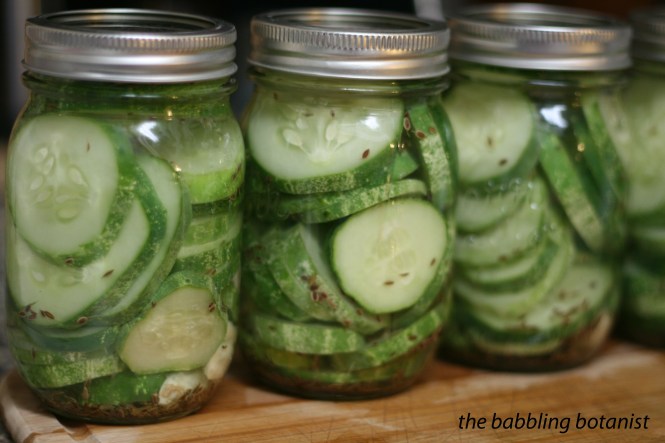
OK, so on to the making of the pickles. These are the ingredients I used in every jar. Then my experiment consisted of processing some of the jars using the traditional boiling water method, and some using low temperature pasteurization. Then some of those jars had pickle crisp and some did not. Finally, I made a jar also of whole pickles to see if they stay crisper than slices.
Ingredients:
4 lbs pickling cucumbers
14 cloves of garlic
14 heads of dill
28 peppercorns
hot pepper flakes to taste or a dried pepper
3 cups water
3 cups vinegar (5%)
1/4 cup pickling/canning salt
Here’s what I did:
Make the brine by combining the water, salt and vinegar in a saucepan and bringing it to a boil to dissolve the salt. I like to either do this after I see how many jars I filled, or just make a bit extra since I always seem to need more. Place 2 cloves of garlic, 2 heads of dill, 4 or so peppercorns and the red pepper flakes in each jar. To prepare your cucumbers, cut a little slice off the blossom end. This is important for firmness as well, as there is an enzyme in the blossom end that can soften the pickles. Cut them how you like, or leave them whole. Spears, coins, slicers, you decide. I also am doing a comparison with ones that were processed whole versus sliced to see if that makes a difference for crispness. Pack the cucumbers into the jars. Cover with brine, leaving a half inch head space. Remove air bubbles with a plastic or wooden utensil and adjust head space as needed. If adding calcium chloride, add 1/8 tsp per pint jar, or 1/4 tsp per quart jar.
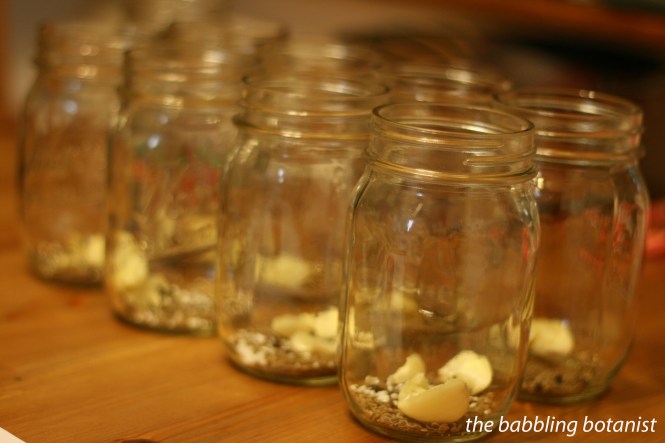
Wipe the rims, apply the lids and bands, and process either for 10 minutes (pints) or 15 minutes (quarts) in a boiling water bath, or for 30 minutes using low temperature pasteurization as described above. After removing the jars from the canner, let them cool 12-24 hours, remove bands, wipe them down, and store for a few weeks before eating them. I took them to canning class a few weeks later and had the students do a blind taste test – read on for the results! Which pickle was the ultimate pickle!?
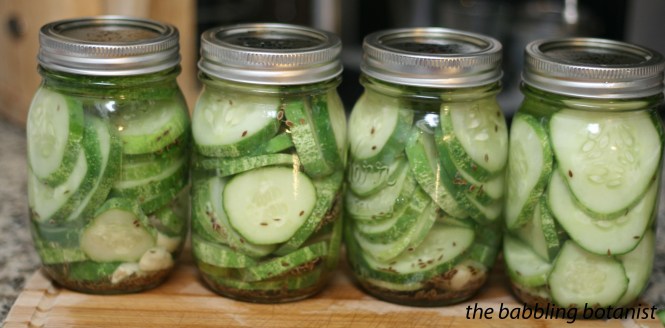
Have you ever tried low temperature pasteurization? Do you have a different secret to super cripsy pickles? Let us know! Or if you’ve had trouble getting your pickles to stay crispy I’d love to hear stories if any one else wants to replicate this experiment. Make some pickles, have a tasting party in a few weeks, and let us know what your friends liked best. Happy pickling!
September update – experiment results!
So, I know you’ve been on the edge of your seat wondering what the results of this experiment would show, so here they are. As a reminder, what I did was 5 different pickles. The pickles were all the same spices and brine, it was the processing that differed. The first 4 were all canned as slices, the fifth was canned whole and sliced for the taste test so people couldn’t tell which one was canned whole. I randomly assigned them to a number 1 though 5 for people to taste test.
1. Boiling water bath, no pickle crisp
2. Low temperature pasteurization, no pickle crisp
3. Low temperature pasteurization with pickle crisp
4. Boiling water bath with pickle crisp
5. Low temperature pasteurization with pickle crisp canned whole
For this taste test I had 17 people test the pickles and rate them from least to most crisp. I wasn’t entirely sure how to analyze the data from the taste test, but some of the results are pretty obvious and exciting. I am going to just give you a few summary statistics that I really think give a pretty clear answer, and I’ve also included all the ratings in case you are really that interested. First off, I wanted to show a picture of the four sliced ones, because even visually some of them looked more crisp, at least to me. Below the jars are in the order listed above, so the two ends were boiled, and the middle two were processed at low temperatures. Can you see a difference? This picture was taken 5 weeks after processing. I think that even visually the boiled ones look soggier. They are a different colour and more translucent.
So how did it break out in terms of numbers? The first obvious result was that 16/17 people put sample 5 as the most crisp sample. So, by canning your pickles whole, with low temperature pasteurization, you get a very crunchy, firm product. Great! Now let’s ignore number 5 for a second since it had an additional variable of being canned whole. 10/17 people chose sample 1 as the softest, and 6/17 chose sample 4 as the softest. This totals to 16/17 people chosing one of the boiled ones as the soggiest. Additionally, of the sliced ones, 13/17 people selected sample 3 as the most crisp, which was the low temperature with pickle crisp sample. Now, I didn’t run any actual stats, but I feel pretty confident saying this: Low temperature pasteurization for the win!! There was not one person that had sample 1 (boiled, no pickle crisp) as anything other than the soggiest or second soggiest. I also thought it was really interesting that Janice, our canning teacher, rated them in the exact order that I would predict. From soggiest to crispest: boiled without pickle crisp, boiled with pickle crisp, low temperature without pickle crisp, low temperature with pickle crisp, low temp with pickle crisp canned whole. Pretty fun! So the method of processing, low temp versus boiling, was detectable by most people. Some people could detect a difference with the pickle crisp, but this result was not as ground breaking. I’d like to test it again, with more people and try doing a boiled one canned whole and a few other things, but I think for now it’s safe to say I will be canning the rest of my pickling cucs at low temps and using pickle crisp. They still turn out well if you don’t can them whole, even though most people picked that for ultimate crispness, but you can also fit less in a jar. So there ya have it! Go can some pickles at 180 F!!
In case you’re crazy like me, here’s everyone’s ratings (least to most crunchy/crisp):
1 4 2 3 5
4 1 2 3 5
4 1 3 2 5
1 2 4 5 3
2 1 3 4 5
1 2 4 3 5
1 2 4 3 5
4 1 2 3 5
4 1 2 3 5
1 2 4 3 5
4 1 2 3 5
1 3 2 4 5
1 4 2 3 5
1 4 2 3 5
1 4 2 3 5
4 1 2 3 5
1 2 4 3 5
*this post contains affiliate links, please see the “About the Blogger” page for more information
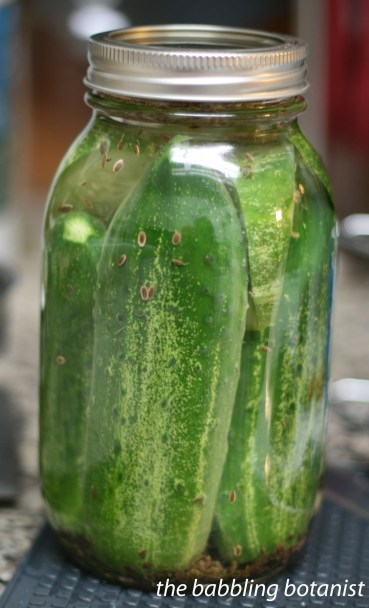
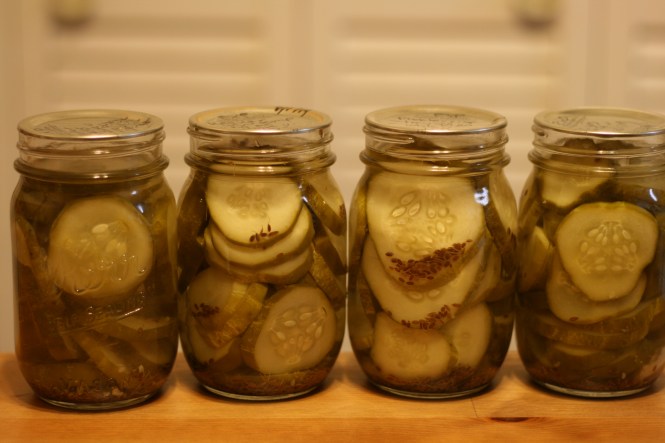

[…] Processing pickles the low temperature pasteurization way. […]
[…] that you can keep your pickles good and crispy when making quick pickles. That post can be found here, and if you missed it just head over and read that, I pasted this entire post there as well. So, I […]
[…] turn it to to keep it at 180-185 F, but I’ll have to update you on that when it arrives. See this post for more info on low temp processing of pickles. Finally, it has a spout on the bottom which means […]
[…] know whether I could maintain 180-185 F for low temperature pasteurization of pickles. More on that here. I was a bit bummed that they weren’t actual temperatures on there, but if it maintains […]
[…] 1. Low temperature pasteurization. To me this is the number 1 way to keep pickles firm, and often one overlooked because a lot of people don’t know it’s a thing. It might not be more important than using a good quality cuc to start with, but I put it first because so many people don’t know about it. Basically, overprocessing pickles can cause them to become soft. With low temp processing, you can process the recipes from this publication PNW 355 at 180-185 F instead of a full rolling boil. It works, it really works. For more on that see my experiment from last year – here. […]
I processed my green tomato pickles at 180 for only 15 minutes, then full boil for a few more minutes. Will they be okay? (Everything sealed)
Hi Lynn,
The 180 degree processing needs to be done for 30 minutes, and right now I think they only have said it’s safe for cucumber pickles. Tomatoes are a pretty high acid food, so you won’t have any issues with the acidity if you pickled them, but that processing time may not have been enough to kill all yeasts or molds in the product.
I’m curious about the 1:1 vinegar/water ratio. I’ve never seen that in a pickle brine, though I’m just an occasional pickler. Are the pickles more sour than normal?
I’m not sure what “normal” would be, since I’ve always done 1:1, but yes you’d probably notice a difference if you are used to a lower ratio. No less than 1:1 is what is recommended for safe quick pickles. Cider vinegar is less sour, so I like to use that rather than white in many of my pickles, or cut the sour with a bit of sugar if you don’t like it.
I’ve recently become interested in pickling. I’ve seen recipes that call for grape leaves in the jar to enhance crispness. The tannins in the leaves are supposedly the reason. I’ve also seen that some pickling spice contains bay leaves which also contain tannins. If you ever decide to continue your research, I would be interested in whether these do, in fact, work and whether the result is comparable to adding calcium chloride. Thanks for your research.
Thanks for your comment. My understanding is that the grape leaves will increase chripness by counteracting the softening enzyme that is found in the blossom end of the cucumber. Therefore, if you cut the blossom ends off you shouldn’t have softening from that enzyme, so it shouldn’t make a difference. However, I can certainly test this theory this year!
I try to be as green, organic and natural as I can so therefore using Pickle Crisp and most Ball products are out. However, I did just successfully do a 64oz jar of dills that are crisp and wonderful just like Bubbies. I used Holm Oak leaves. Last year I tried just cutting the blossom ends off and it didn’t work. But this latest batch is awesome. Crisp. Flavorful. Competitive with commercial brands.
Awesome!
Pickle crisp is calcium chloride – these two molecules are responsible for making you blood pump and your heart work and many other reactions in you body! They immediately separate in the water and enter the cucumber (where they already exist) to strengthen the cell membranes in the cucumber. If you have ever gotten IV fluids you have had this injected into you. You want to avoid roundup on your veg totally understand though – me to.
The low temp method calls for 30 minutes at 180 – 185 degrees. Does this apply to both pints and quarts, or are there shorter processing times for pints?
Stew…
Low temp calls for 180 – 185 degrees for 30 min. Can you process pints for less time?
Hi Stewart, both sizes are the 30 min time. Cheers, Caitlin
Is this method safe for pickled jalapeño rings? And, what do you make of this?
https://www.chefsteps.com/activities/make-crisp-flavor-packed-pickles-on-the-quick
Hi John,
In the early editions of the method the experts said you could use this method for things other than just cucumbers, but last year they revised it to say cucumbers only. I would think it would work, but I guess they changed their recommendations because they were finding spoilage in some things other than cucumbers. Here’s the newer version of PNW 355. You can see in this edition it doesn’t list it for the pickled peppers.
Meant to attach that link! http://extension.oregonstate.edu/fch/sites/default/files/documents/pnw_355_picklingvegetables.pdf
Did you get a chance to look at the Chefsteps link that I attached. They use a sous vide method which involves processing at 140F for 2 1/2 hours. I have a Joule precision circulator so I tried their method and the resultant pickles were very crisp.
Altough I’m super late to the party, I wanted to thank you so much for posting this, and saving me the time of doing the same experiment. Fantastic and really interesting information. I’m wondering if my Anova Sous Vide could maintain the temp in my big ole canner. If so, that’d be perfect. I’ll try it with jars filled with water, and double check with a thermapen.
[…] For more on this process, I recommend reading this piece on Healthy Canning and this one on The Babbling Botanist. […]
I read that you can substitute dried dill seed for the dill dead. The equivalence was listed at 1 Tbsp = 1 dill head. Looking at your recipe, you call for two dill heads, but 2 Tbsp of dill seed per pint seems like a lot. Do you think that conversion is correct? If not, how much dill seed would you recommend per pint jar?
I LOVED this article because it’s giving me hope after frustrations with the boiling water bath method. I’m about to give this another try with my sous vide. Does it matter if my cucumbers were picked a few days ago and if the size of the cucumber matters with regard to crispness?
Never have water bathed my pickles. I have put the ina 250 oven for 45-60 mins with loosened lids( 1/2 turn back after tightening.) also just have very hot jars, lids and brine and seal , no bath. I do use pickle crisp, and I do soak them whole with a salt and ice water for up to 4 hours. I have also boiled my garlic with my brine this year, we will see after I open my first jar. Garlic has bacteria.
Hi,
can i dissolve the pickel crisp in to the brine/vinegar mix so save one step in the processing?
I don’t see a reason not to do that.
[…] Processing pickles the low temperature pasteurization way. […]
Is it necessary to start at 120-140 degrees? Could the jars of cucumbers have boiling brine added to them and placed immediately in a water bath at 180 degrees? It would save a lot of time to not cool the bath down between batches.
Strictly speaking, the recipes are tested as written and they include the warm-up time as part of the recipe so you’re supposed to start at that temp.
I always use the low heat method for my dill pickles along with 1/8 tsp pickle crisp and a bay leaf. This year I also added a horseradish leaf or half depending on the size. I saw that on a YouTube video and it worked great with my fermented pickles, so I figured why not.